The Association of Museums and Galleries of the Czech Republic (Asociace muzeí a galerií České republiky, hereinafter only AMG) offers more than two thousand records about Czech museums and galleries in its directory. You can find all the museums dealing with folk culture on the website Museums.
Czech Folk Culture
A long-term ethnographic exhibition of the National Museum in Prague: www.nm.cz/Historicke-muzeum/Expozice-HM/Ceska-lidova-kultura.html
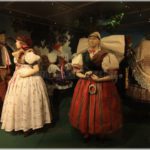
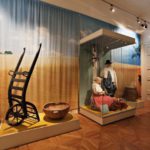

The exhibition presents everyday and festive life in Bohemian, Moravian, and Silesian countryside in the 18th and 19th centuries and in the first half of the 20th century, as well as traditional folk culture in the Czech Republic.
The first section of the exhibition shows everyday life with emphasis on tangible culture. This exhibition also includes products and tools used by folk craftsmen and peasants (folk ceramics, habitation), as well as unique exhibits associated with feasts and festivals and with spiritual culture (folk costumes, folk art). The other section of the exhibition presents folk traditions, annual customs and ceremonials of traditional farming year – beginning with spring (Shrovetide, Easter) through summer and autumn (Pentecost, summer pilgrimages, harvest festival) to winter (St. Nicholas and Advent door-to-door processions, Christmas traditions associated with Christmas Eve celebration). The closing section of the exhibition shows human life cycles (birth death, wedding) and family ceremonials associated with human life. The exhibition is supplemented with three workshops (presenting the production of ceramics, textiles, and handicrafts associated with traditional customs) and it also presents folk handicrafts and handmade production. In the year 2007, the Ethnographical Exhibition of the National Museum was nominated for the European Museum of the Year Award.
Traditional Folk Culture through Touch
A long-term exhibition of the National Museum in Prague: www.nm.cz/Historicke-muzeum/Expozice-HM/Tradicni-lidova-kultura-dotykem.html

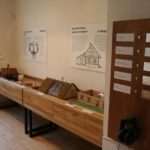
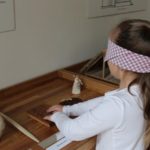
The long-term exhibition “Traditional Folk Culture through Touch” brings selected topics related to the rural life of our ancestors at the turn of the 19th and 20th centuries to both visually impaired and blind visitors. The exhibition presents products and tools used by folk craftsmen, examples of traditional folk songs and costumes, as well as samples of legumes, cereals, and herbs used to prepare food. Those interested can also explore a wooden three-art four-dimensional model of the rural house.
Every visitor can learn more about the objects that represent the traditional folk culture. There are eye masks placed in exhibition rooms with which those interested can pass through the exhibition using their touch and thereby acquaint themselves with the world of the blind and the visually impaired. The exhibition is accompanied by supplementary programmes, presentations of items used at festive times, and commented programmes explaining traditional feasts, folk customs and traditions, not only for the blind and visually impaired visitors, but also for visitors from schools and interest clubs. An accompanying catalogue titled “Traditional Folk Culture through Touch”, written in Braille and black print.
Folk Clothing in Moravia
National Institute of Folk Culture in Strážnice: www.nulk.cz/?exhibition=lidovy-odev-na-morave
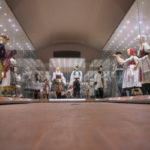
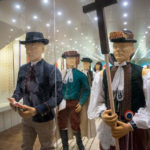
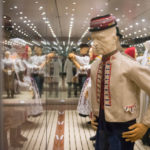
On the occasion of the 70th International Folklore Festival in Strážnice held in 2015 an exhibition titled Folk Dress in Moravia was opened to the public. The exhibition is one of the outcomes of the Programme of Applied Research and Development of National and Cultural Identity. You can see the presentation of the exhibition on http://vystava.lidovyodev.cz/.
Due to its exceptional location, Moravia is influenced by several significant ethnographic areas that distinguish peculiar clothing culture. In the east, bordered with the Carpathian Mountains, people wore garments related to pastoral culture the elements of which reach to Wallachia and the ethnographic area of Moravian Kopanice. In contrast to this, the south and south-east, meaning the ethnographic areas of Podluží and Strážnicko, are closely related to the lowlands in western Slovakia and Pannonia. In the ethnographic area of Haná, which is situated in the core of the lowlands along the Morava River, several elements of local clothing constructions have survived, the history of which reaches back to the Middle Ages. In contrast to what is described above, northern, western, and partially central and southern Moravia bears traces of west-European stylized clothing whose urban variants began to spread to the countryside in the late the 18th century. In the past, the western type of folk costumes arrived in the northern part of the Kyjov area, and it is still worn in Vracov. Several garments worn as part of this folk costume, such as women´s and men´s vests and jackets, spread to neighbouring eastern regions, in which they gradually changed the established form of folk dress.
Taking into consideration the diversity of clothing material, we have divided the exhibition into three exhibition halls. Each of them presents a certain geographical part of Moravia and particular situations and types of folk costumes which the rural residents used to wear. The entrance hall pays homage to Slovácko, an ethnographic area where folk costumes were worn for the longest time and which features the biggest quantity of folk-costume types. The exhibited ensembles present ceremonial and festive clothes worn by brides and bridegrooms, their parents, bridesmaids and groomsmen and wedding guests. The second part of the exhibition creates the atmosphere of a fair. Fairs were gatherings of people who came from near and far away; for this reason, the fairs were typical for a variety of folk costumes and dialects. You can see residents from southern, western and central Moravia, meaning from the ethnographic areas of Horácko, Brněnsko and Malá Haná, who set out on the journey to Brno. This hall shows also clothing worn by national minorities that lived in Moravia, whether Croatians from the Mikulov area or German-speaking inhabitants in the Jihlava and Vyškov areas and the Hřebečsko region. The last part of the exhibition presents pious pilgrims from the ethnographic areas of Haná and Wallachia, who met in Velehrad, a pilgrimage site where they came to celebrate the anniversary of Cyril and Methodius.
Earth Architecture
National Institute of Folk Culture: www.nulk.cz/?exhibition=hlinene-stavitelstvi
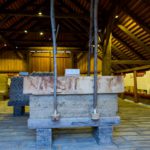
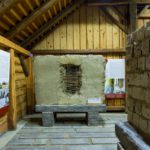
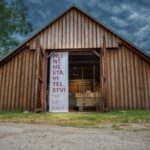
The exhibition “Earth Architecture in Moravia” is one of the outputs resulting from the Applied Research and Development of National and Cultural Identity Programme (NAKI) and titled “The Techniques of Traditional Earth Architecture in Moravia and its Relationship with the Mid-Danube Area”. The National Institute of Folk Culture alongside Masaryk University was to solve this project funded by the Ministry of Culture of the Czech Republic.
The conducted research focussed on a thorough analysis, practice, and renewal of techniques applied in Moravia in the past, within the context of the “rural house of Pannonian type” that was typical for dales in central and southern Moravia. Earth constructions represent the most endangered groups of historical buildings situated in the country, and they are an important witness to the life of former generations. The exhibition presents a varied spectrum of archaic constructional solutions of walls in earth buildings. Nine exhibits depict an extinct building tradition which is represented by a fragment of the mostly fading buildings on the ground. Earth buildings are a significant part of tangible culture of rural residents, with which the hitherto ethnological research has not dealt comprehensively yet.
Slovácko Permanent Ethnographical Exhibition
Slovácko Museum in Uherské Hradiště: www.slovackemuzeum.cz/doc/18/
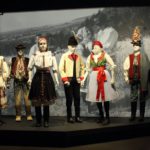
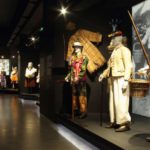
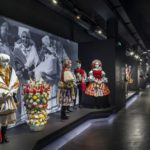
The permanent ethnographical exhibition titled “Slovácko” [an ethnographic area in South Moravia, also called Moravian Slovakia] was opened to the public in 2014. The exhibition is divided into several sections which are mutually interconnected and tied to each other. The way of earning livelihood was crucial for the life of rural residents, which in Slovácko mainly meant farming with many accompanying activities, such as husbandry, beekeeping, fishing, and viticulture. As a consequence, vernacular architecture defined not only cultural landscape, but also necessities of rural residents´ lives. Another separate section of the permanent exhibition focusses on folk handicrafts beginning with traditional pottery through processing of textile yarns to working with wood including high artistic level of safeguarded examples of folk woodcarving. Folk clothing is a large and varied section which, to a certain degree, penetrates the section devoted to family and annual ceremonies. A stop in the middle of the exhibition presents various folk costumes from Slovácko beginning with garments of simple cut and decorations, worn in the mountainous regions of Moravian Kopanice, through richer folk costumes of the regions of the Buchlovice area, Luhačovické Zálesí, and Uherský Brod area to the wealthy Uherské Hradiště, Kyjov and Strážnice areas and the ethnographic area of Podluží.
The follow-up section presents family and annual traditional cycles. Human life flowed from birth to death, passing an essential turning point, meaning the wedding. Every year, the annual cycle was accompanied by Shrovetide processions, Easter customs, Pentecost traditions, and harvest and vintage festivals. The traditional year´s end, the period of Advent, was typical (not only) for the door-to-door processions with magical figures of St. Nicholas and his entourage, and Lucias, but mainly it was a period of thinking about the direction of a human´s life, which, alongside sunbeams on always shorter days, was heading for its end. The whole life was accompanied by piousness and folk belief with all expressions of it, including worshipping the patron saints who protected harvest, households, and craftsmen and their labour.
Jak jde kroj, tak se stroj [When in Wallachia, Do as the Wallachians Do]
Wallachian Open-Air Museum in Rožnov pod Radhoštěm: www.vmp.cz/cs/programy-a-vystavy/vystavy/jak-jde-kroj-tak-se-stroj.html, photo: Jan Karásek, www.denik.cz
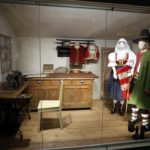
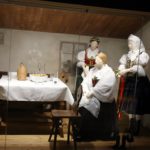
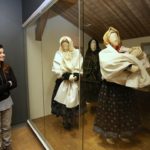
The long-term exhibition is ready to introduce you the variety and beauty of traditional and civil textiles and garments worn by our ancestors at diverse occasions in the period approximately from the late 18th to the mid-19th century. Through the exhibits, the exhibition focusses on demonstrating the historic development and influences forming the appearance of traditional dress worn in Wallachia from the time of the first known historical sources until the mid-20th century to amateurs and professional who are interested in the topic. Transformations in the appearance of garments and ensembles are presented mostly through original three-dimensional and two-dimensional objects which are part of the Wallachian Open-Air Museum´s collections, as well as through reconstructions, copies, and reproductions of them. The exhibits are placed in display cases and dioramas giving an impression of particular situations and scenes of life, which significantly influenced the character of clothing worn at a given occasion. The final part of the exhibition offers a unique opportunity of taking a look into the study depository which presents the diversity of traditional clothing worn in Wallachia on selected collection items.
Dlask Farm
Museum of the Bohemian Paradise in Turnov (web)

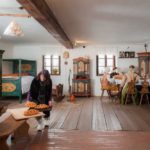
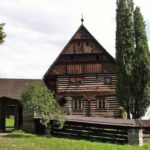
Dlask farm is a typical example of traditional vernacular architecture of Turnov type from the 18th century. Originally, the farm was owned by the Dlask family of farmers with Josef Dlask, born 1782, being the best-known from them. As a popular well-read person, village mayor in Dolánky, and pioneering farmer, he was an important figure in the regional history. The Dlask farm includes a log residential house with composed gable and gallery which are typical for the regions along the Jizera River. In 2010, the farm was declared a national cultural monument. At the entrance into the farmyard, there is a statue of the Virgin Mary from the year 1784 and a one-storeyed log granary, which was relocated from Malý Rohozec in the 1960s. Since 1967, the entire precinct is part of the Department of Ethnography of the Museum of the Bohemian Paradise in Turnov, which opened the buildings to the public in 1969. Nowadays, one can find a permanent exhibition displaying vernacular interior and homemade products in the region along the Jizera River, supplemented with short-term exhibitions. The farmyard is encircled by walls made of beams, and it accommodates traditional folk feasts several times a year, mainly at Easter, kermesse, and Shrovetide.
From the Cradle to the Grave
Regional Museum in Olomouc (web)
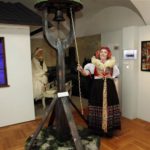
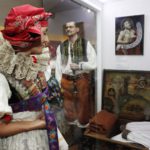

The permanent ethnographic exhibition, which was ceremonially opened in the Regional Museum in Olomouc on 3 December 2013, is thematically oriented, in contrast to other permanent exhibitions being installed recently. The exhibition tries to show to the visitors how people, within their communities, were since the time immemorial coming to terms with the basic poles of human existence, meaning the birth and the death. The theme was chosen intentionally because it touches everyone among us. The theme is set in a real environment of a village in the ethnographic area of Haná and the local countryside of the 19th century. The exhibition focusses on involving the visitors in what happened in the then environment to allow them to experience basic emotions of joy and grief, to think about the perception of human existence long ago and now, and to understand the thinking of our ancestors and to appreciate their approaches to the life. Through the chosen theme, the exhibition offers the widest possible spectrum of items used “in one´s life” to the visitors. The presented items come mostly from the Ethnography fonds. These include folk furniture, household articles, ceramics, broadside prints, folk art, folk costumes, and religious objects. A significant part of collection items comes from old collecting actions conducted by the Vlastenecký spolek muzejní [Patriotic Museum Club]. The exhibitions is divided into three sections which complement each other in a natural way: these are “Birth” – “Piousness” and – “Death“.
Ethnography in the Ethnographic Areas of Haná and Záhoří
Komenský Museum in Přerov (web)
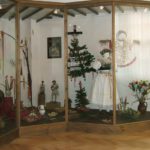
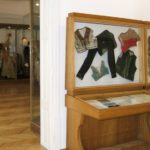
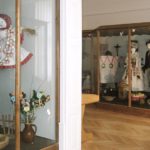
In its largest room, the permanent exhibition presents the region of central Haná, and on the examples of folk costumes and traditional items it explains folk customs in a calendar year from spring to winter. The spring is represented by a girl wearing a folk costume from Haná and by Easter – a symbol of spring. The summer depicts a farmer and his wife and folk traditions related to the end of field works. The autumn is symbolized by a woman wearing a traditional mourning costume and by customs held in the period of the All Souls´ Day. The winter is demonstrated by a female spinner, dressed in an everyday folk costume, as sitting in the main room of the farm, as well as by pastries made on St. Nicholas Day and at Christmas, and by Shrovetide customs. The visitors can also admire the local wedding with beautiful local folk costumes and a typical wedding cake. The display case placed in the corner presents indigo-dyed items (also called blueprint) produced by the Bayer´s workshop in Přerov. Indigo-dyed linen was an important textile for making folk garments – skirts and aprons. The other room focusses on the life of Hanakian people living in the region of Záhoří from the birth to the old age (birth, childhood, school attendance, wedding customs, adulthood, and old age) with emphasis on traditional dress and household articles. Two table-style display cases present examples of small folk garments worn in the region of Hannakian Záhoří.
How Our Forefathers Used to Build
Wallachian Open-Air Museum in Rožnov pod Radhoštěm: www.vmp.cz/cs/programy-a-vystavy/vystavy/jak-staveli-nasi-predkove.html
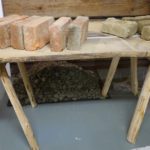
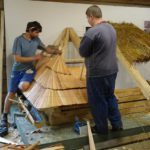
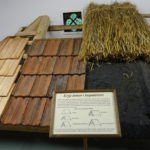
The permanent exhibition aimed at carpentry explains the skills of past generations through original items, historical photographs, documenting drawings, and particular building elements. The exhibition is divided into several independent thematic ranges which allow the visitors to learn about craftsmanship of former craftsmen´s building skills. Let us choose several topics: trunk, interlocking of logs, roof, gable, and mud. Several interactive elements have been prepared for children visits; these try to involve the children in the world of traditional architecture and to explain some interesting things and interconnections to them. The exhibition is accompanied by several competitions – for example to recognize trees as to their trunks and bark, and historical tools, or to set a wooden puzzle together.
The exhibition includes several rarities: a village mayor´s house from the nearby village of Hážovice, examples of historical roofing used in Wallachia, demonstrations of beam hewing including the tools used, production of shingles, and handmade production of bricks.
Further techniques, associated with traditional architecture, will be displayed through exhibited items which were said to have magic and protective functions. Those interested can also find historical building elements from extinct houses.
Wood, Wicker, and Straw in Traditional Handicrafts
Malenovice Castle, Museum of South-East Moravia in Zlín: http://www.muzeum-zlin.cz/cs/stranky/hajenka/
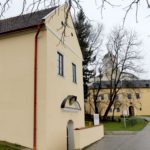


The permanent exhibition presents homemade production using the common natural materials – wood, wicker, and straw – as a significant part of traditional folk culture. The visitors can see not only finished products with their functional and aesthetical value, but also a summary of skills which allowed the rural creators to use natural materials for the creation of articles necessary to maintain their life and to develop their existence. The exhibition displays production techniques which also demonstrate producers´ craftsmanship and ingenuity, resulting from human´s harmony with and firm ties to the nature. This was the reason why useful, long-life, and beautiful items could be made. An independent section is devoted to wood-carving and region´s traditional architecture, which took advantage of wood and straw. It also presents works by important creators of the region. The exhibition also includes video-documentaries depicting traditional production techniques.
Běliště Ethnographic Exhibition
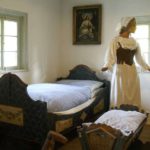
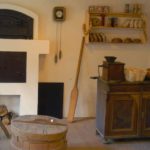
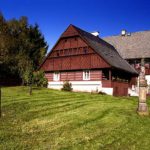
Běliště is the biggest and most beautiful construction of vernacular architecture in Železný Brod. Today, it accommodates the ethnographical permanent exhibition of the Železný Brod Town Museum.
The building was constructed in the year 1807, and in the garden a group of sculptures is placed. Long ago, there was a tannery operated in the building which is a modern-day home to the ethnographical collection of the town museum. Each of its nine rooms focusses on a particular realm in the history of Železný Brod and its nearest environs. The visitors can see an old school class, a cobbler’s corner, guild items, a bakery and gingerbread bakery, articles to process flax, a small room for a home weaver, garments from the last century, wooden Nativity Scenes, and unique models of burghers´ houses. The attic offers an exhibition with wooden box-shaped Nativity Scenes, and models of burghers´ houses which used to stand in the square of Železný Brod. The visitors also like one of the local popular attractions, a barrel organ with nine melodies, which often plays in Běliště even today.
Life in the Blata and Kozácko Regions
Blata Museum in Soběslav and Veselí nad Lužnicí (web)
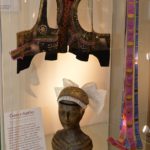
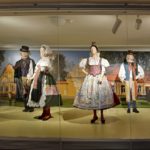
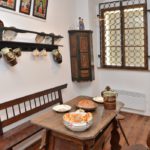
The new ethnographic permanent exhibition was ceremonially opened on 23 June 2017, at the occasion of the sixth Night in the Blata Museum and with the participation of Eng. Vlastislav Ouroda, PhD., Deputy of the Minister of Culture. As announced by the title, the exhibition deals with traditional life in the region of Blata (marshes) around Soběslav and Veselí nad Lužnicí, and that of Kozácko which is situated further north. The exhibition occupies ten halls in the reconstructed Smrček house, which makes it the largest compact ethnographic exhibition in southern Bohemia. Come to see women from the Blata region as wearing their local folk costumes and meeting in the village green, and to visit the main room in a Blata farm from the 19th century! Similarly, you can admire folk costumes and other expressions of folk culture from Blata and Kozácko, as well as vernacular architecture, traditional farming and handicrafts. A mention about the extraction of peat cannot be missing! Emphasis is put on authentic exhibits selected from voluminous museum collections. The exhibition also presents contemporary works by the southern-Bohemian craftsmen who were awarded the Bearer of the Tradition of Folk Craft title. The visitors can buy their products in the museum shop.
Ethnographical Exhibition in Kobylí
Museum, Kobylí na Moravě (web)
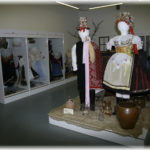
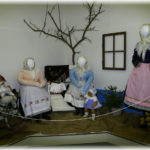
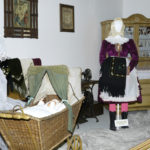
The museum in the village of Kobylí was opened in the old building of the former elementary school in 1997, supported by exceptional efforts carried out by the Club of History Friends and by the municipality. The museum succeeded in creating a large ethnographical permanent exhibition focussed on the ethnographic area of Hanakian Slovácko, which only hardly can find a competition in the close surrounding. Every year, the museum tries to improve the installation in terms of quality. Nowadays, the visitors can learn about the history of Kobylí and the development of local folk costumes, and they can also see a farmer-style kitchen, listen to a programme describing how boys proposed marriage with a scene from a rural house in the background, and visit rooms displaying tools and agricultural machines. Each tour mostly ends in the cellar which have been renovated and which accommodates an exhibition about viticulture.

